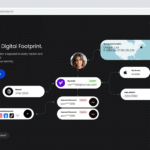New Malwarebytes tool lets you see where your data is exposed

With so many data breaches having taken place it's almost inevitable that at least some of your personal information has been exposed online. But finding out exactly what can be tricky.
Malwarebytes is launching a new web portal that gives individuals deep visibility into their exposed personal information, so anyone can easily see where and when a breach compromised their data, types of data exposed, and specific personal data for sale on the dark web.
Large businesses struggle to tackle cyber threats

Large businesses are finding it significantly more difficult to manage their cybersecurity than their smaller counterparts, according to new research from passwordless authentication company IDEE.
Based on a survey of more than 500 IT and cybersecurity professionals within UK businesses, the data reveals that 74 percent of respondents from large businesses (more than 500 employees) believe it has become far more challenging to defend against cyber attacks since the Covid-induced rise of remote and hybrid working.
Get 'Cybersecurity and Decision Makers: Data Security and Digital Trust' (worth $142) for FREE

Cyber security is a key issue affecting the confidence of Internet users and the sustainability of businesses. It is also a national issue with regards to economic development and resilience.
As a concern, cyber risks are not only in the hands of IT security managers, but of everyone, and non-executive directors and managing directors may be held to account in relation to shareholders, customers, suppliers, employees, banks and public authorities.
Women face exclusion from cybersecurity roles

A new report uncovers widespread gender disparities in the cybersecurity workplace, with women encountering exclusion at twice the rate of men.
The study -- from Women in CyberSecurity (WiCyS), a non-profit organization dedicated to the recruitment, retention and advancement of women in cybersecurity, in conjunction with with DEI firm Aleria -- finds the top four categories of exclusion faced by women are: respect, career and growth, access and participation, and recognition.
Auto industry is prime target for email attacks

The automotive industry has become a popular target for business email compromise and vendor email compromise attacks, according to new research from Abnormal Security.
Between September 2023 and February 2024, BEC attacks against businesses in the automotive industry increased by 70.5 percent. Over the same period 63 percent of Abnormal Security customers in the automotive industry experienced at least one VEC attack.
Why you should worry more about SaaS than generative AI [Q&A]

There's a lot of talk at the moment about how the use of AI opens up businesses to additional risk. But is AI itself the issue or is it the way in which it's integrated with other applications?
We talked to Ran Senderovitz, chief operating officer of Wing Security, to discuss how enterprises need to re-prioritize their security to address the real attack surface, the SaaS apps that leverage AI.
Insider threats linked to nation states increase 70 percent

Insider threats are usually thought of as being down to disgruntled or careless employees, but a new report from risk management specialist DTEX finds insiders have never been more vulnerable to interference from nation state actors.
The report, by the DTEX Insider Intelligence and Investigations (i3) team, based on more than 1,300 investigations within DTEX's global customer base, finds investigations into insider threats from nation-states and foreign interference increased 70 percent since 2022, mainly within critical infrastructure and public sector.
Quantum threat highlights need for digital trust

With the National Institute of Standards and Technology (NIST) expected to finalize post-quantum cryptography (PQC) standards in the second half of 2024, a new report from Keyfactor explores the challenges that create barriers to building a strong foundation of digital trust.
It finds that only 23 percent of organizations have started work on PQC, with 36 percent expecting to start after the first release of standards later this year. Another 25 percent of organizations will begin implementing PQC when standards are finalized.
Malicious search engine ads drive latest phishing threat

New research from BlueVoyant shows the use of malicious search engine ads is on the rise and poses a significant threat to internet users and companies.
These ads can lead to phishing websites or malware downloads, putting personal, financial and corporate information at risk. For companies, a compromise via phishing can lead to brand reputation damage, financial loss, and loss of customer trust.
Businesses not prepared for AI-based attacks

A new survey of almost 1,800 security leaders and practitioners in 14 countries, finds 74 percent of respondents believe AI-augmented cyberthreats are already having a significant impact on their organizations, yet 60 percent believe they are currently unprepared to defend against these attacks.
The study from Darktrace shows 71 percent of respondents are confident that AI-augmented security solutions will be able to detect and block AI-augmented threats. However, only 26 percent fully understand which types of AI are used in their security stack today.
Is your zero trust program at risk of failure? [Q&A]

Zero trust is no longer a 'nice to have' for cybersecurity leaders. As organizations embrace hybrid and remote workforces, the volume of cyberattacks and data breaches involving unauthorized access to networks, applications and systems has surged.
In response, cybersecurity leaders are striving to adopt a zero trust approach to security to reduce the risk of data breaches, ransomware and insider threats. However, the success of these efforts are being undermined by a variety of factors.
Almost a quarter of consumers consider cybersecurity when choosing a bank

What factors do you take into account when choosing a bank? How good the interest they offer on your savings is perhaps? Whether there's a convenient branch nearby? How easy the website is to navigate? A new study shows that 23 percent of US and UK consumers say that a bank's approach to cybersecurity is a factor when they consider opening an account.
The research from CybSafe finds that 85 percent of customers feel it important that their bank offers training about staying safe online and avoiding scams to those who want it, with 42 percent of respondents stating that such measures are 'very important'.
Industry turns to zero trust

A new study of industrial enterprises shows 72 percent have started adopting zero trust principles, with 38 percent of organizations establishing, implementing, and optimizing zero trust control measures.
The study from Xage and Takepoint Research surveyed over 250 cybersecurity senior leaders across critical infrastructure organizations, energy, utilities, transportation, oil and gas and manufacturing to gauge the current state of zero trust implementation.
21 percent of S&P 500 companies reported breaches in 2023

According to the latest threat research from SecurityScorecard, 21 percent of S&P 500 companies experienced breaches in 2023.
The report shows that 25 percent of these breaches impacted financial services and insurance companies. Financial institutions have some of the most robust security programs because they have substantial money and assets. But the interconnected nature of the financial sector means that compromising one institution or commonly used product can lead to broader impacts across the entire industry.
79 percent of security pros don't think their company has adequate protection

Half of security professionals say it's almost impossible to find the right balance between security and employee productivity, and 79 percent don't think their security protections are adequate.
A new study from 1Password, based on a survey of 1,500 North American workers, including 500 IT security professionals, finds 69 percent of security pros admit they're at least partly reactive when it comes to security. While 61 percent believe they're being pulled in too many conflicting directions.
Recent Headlines
Most Commented Stories
BetaNews, your source for breaking tech news, reviews, and in-depth reporting since 1998.
© 1998-2025 BetaNews, Inc. All Rights Reserved. About Us - Privacy Policy - Cookie Policy - Sitemap.